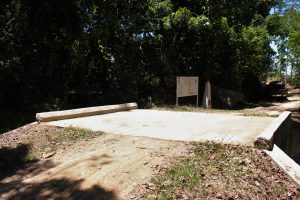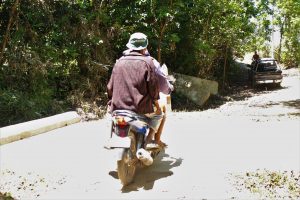Imagine students from Brgy. M. Chavez, San Lorenzo, Guimaras working hard to pass all the subjects in school. Most of them worry about assignments, projects, and other school requirements.
Yet, every single school day, they have to face another struggle on the way to school- to cross the water ways.
In 2014, the municipal government of San Lorenzo, Guimaras built an overflow to give temporary relief to residents especially the students while crossing the river. Somehow, the overflow was beneficial but its purpose was not maximized especially during rainy season. The area is still flooded. Eventually, the structure was destroyed.
Barangay Sub-Project Management Committee Chairperson Mercy Bayoneta said the community then made another remedy by putting a thick piece of wood as an alternative path after the overflow was wrecked. Passengers have to alight from the motorcycles and cross the area on foot since the wood can only accommodate lighter capacity of load.
“Ang mga kabataan ginasugat dul-ong gid namon para maensure ila nga safety sa pagtabok dira sa naguba nga overflow. Especially kon gainulan, kinahanglan gid updan ang kabataan magtabok.”, said Bayoneta. (We had to bring and fetch our children from school to ensure their safety while crossing the overflow. Especially during rainy season, it is really a must to accompany the children while crossing.)
When it rains hard and the flood rises, the area becomes a dangerous path for students, as they might be carried away by the strong current. Students are even supervised in crossing the area to ensure their safety. Motorcycles cannot also cross. And if the flood worsens, the path becomes a water way for strong water current and impassable, she said.
If this happens, not only the students get compromised, but also the residents who have goods to transport to the town proper.
Residents from nearby barangays Aguilar and Gavan, who uses Barangay M. Chavez as alternative route were affected.
“Sang una ginahulat gid namon maghupa ang baha para lang madala ang amon nga produkto pakadto sa market, (Before, we really wait for the water to subside to be able to bring our goods to the market),” said Arturo Pillora Jr., Kalahi-CIDSS community volunteer.
In October 12, 2016, through the funding of Kalahi-CIDSS, the community prioritized the construction of a box culvert for Kalahi-CIDSS funding, seeing its necessity.
Bayoneta said community are all participative during the project implementation. They helped in whatever ways they could believing that once the project is completed it will not only benefit the current generation but also the future generation.
“Willing gid ang pumuluyo nga maghatag sang ila nga serbisyo tungod nga para man ini sa ila. Kag magamit man sa mga susunod nga henerasyon,” (The residents are really willing to render their service for this sub-project for they know that it will really help our community. The project will also be beneficial to the succeeding generations), she said.
Now, parents need not worry about their children going to school. They are now assured that the kids will not have to cross a perilous water ways. People of M. Chavez and its neighboring barangays can now freely transport their goods to town without crossing the water ways by foot.
“Dako gid ang bulig sang box culvert para sa mga pumuluyo. Hindi na kami magkabalaka kon gainulan. Safe na ila nga pagkadto kag pagpuli halin sa eskwelahan (The box culvert was really a big help to the residents. We don’t need to worry anymore when it rains. It’s is already safe for them [students] to travel from home to school and vice versa),” added Bayoneta.
Bayoneta said that it is through Kalahi-CIDSS that they were able to see the beauty of their barangay. “Ang M. Chavez, kon wala nasudlan sang Kalahi-CIDSS, malabo gid guro nga mahimo nga manami ang amon nga barangay. Safe na kami sa adlaw-adlaw kag nami na tulukon ang dalan kay wala na gabaha.” (If it is not with Kalahi-CIDSS, we would not be able to appreciate our barangay. Now, we feel safe everyday and it is really nice to see that our road is not flooded anymore).”
Now, the community is protected. Students can go their school without too much hassles while farmers can transport their goods to the market anytime of the day.#


